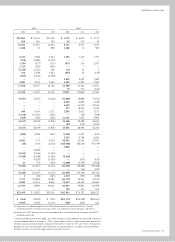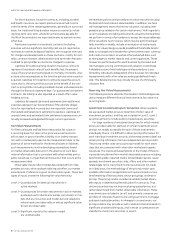GE 2012 Annual Report Download - page 83
Download and view the complete annual report
Please find page 83 of the 2012 GE annual report below. You can navigate through the pages in the report by either clicking on the pages listed below, or by using the keyword search tool below to find specific information within the annual report. GE 2012 ANNUAL REPORT 81
notes to consolidated financial statements
Partial Sales of Business Interests
Gains or losses on sales of affiliate shares where we retain a con-
trolling financial interest are recorded in equity. Gains or losses on
sales that result in our loss of a controlling financial interest are
recorded in earnings along with remeasurement gains or losses
on any investments in the entity that we retained.
Cash and Equivalents
Debt securities and money market instruments with original
maturities of three months or less are included in cash equiva-
lents unless designated as available-for-sale and classified as
investment securities.
Investment Securities
We report investments in debt and marketable equity securities,
and certain other equity securities, at fair value. See Note 21 for
further information on fair value. Unrealized gains and losses
on available-for-sale investment securities are included in
shareowners’ equity, net of applicable taxes and other adjust-
ments. We regularly review investment securities for impairment
using both quantitative and qualitative criteria.
For debt securities, if we do not intend to sell the security
or it is not more likely than not that we will be required to sell
the security before recovery of our amortized cost, we evaluate
other qualitative criteria to determine whether we do not expect
to recover the amortized cost basis of the security, such as the
financial health of and specific prospects for the issuer, including
whether the issuer is in compliance with the terms and covenants
of the security. We also evaluate quantitative criteria includ-
ing determining whether there has been an adverse change in
expected future cash flows. If we do not expect to recover the
entire amortized cost basis of the security, we consider the secu-
rity to be other-than-temporarily impaired, and we record the
difference between the security’s amortized cost basis and its
recoverable amount in earnings and the difference between the
security’s recoverable amount and fair value in other compre-
hensive income. If we intend to sell the security or it is more likely
than not we will be required to sell the security before recov-
ery of its amortized cost basis, the security is also considered
other-than-temporarily impaired and we recognize the entire dif-
ference between the security’s amortized cost basis and its fair
value in earnings. For equity securities, we consider the length
of time and magnitude of the amount that each security is in an
unrealized loss position. If we do not expect to recover the entire
amortized cost basis of the security, we consider the security to
be other-than-temporarily impaired, and we record the difference
between the security’s amortized cost basis and its fair value
in earnings.
Realized gains and losses are accounted for on the specific
identification method. Unrealized gains and losses on investment
securities classified as trading and certain retained interests are
included in earnings.
Inventories
All inventories are stated at the lower of cost or realizable values.
Cost for a significant portion of GE U.S. inventories is determined
on a last-in, first-out (LIFO) basis. Cost of other GE inventories is
determined on a first-in, first-out (FIFO) basis. LIFO was used for
37% and 38% of GE inventories at December 31, 2012 and 2011,
respectively. GECC inventories consist of finished products held
for sale; cost is determined on a FIFO basis.
Intangible Assets
We do not amortize goodwill, but test it at least annually for
impairment at the reporting unit level. A reporting unit is the
operating segment, or a business one level below that operating
segment (the component level) if discrete financial information
is prepared and regularly reviewed by segment management.
However, components are aggregated as a single reporting unit
if they have similar economic characteristics. We recognize an
impairment charge if the carrying amount of a reporting unit
exceeds its fair value and the carrying amount of the reporting
unit’s goodwill exceeds the implied fair value of that goodwill. We
use discounted cash flows to establish fair values. When avail-
able and as appropriate, we use comparative market multiples
to corroborate discounted cash flow results. When all or a por-
tion of a reporting unit is disposed, goodwill is allocated to the
gain or loss on disposition based on the relative fair values of the
business disposed and the portion of the reporting unit that will
be retained.
We amortize the cost of other intangibles over their estimated
useful lives unless such lives are deemed indefinite. The cost of
intangible assets is generally amortized on a straight-line basis
over the asset’s estimated economic life, except that individually
significant customer-related intangible assets are amortized in
relation to total related sales. Amortizable intangible assets are
tested for impairment based on undiscounted cash flows and, if
impaired, written down to fair value based on either discounted
cash flows or appraised values. Intangible assets with indefinite
lives are tested annually for impairment and written down to fair
value as required.
GECC Investment Contracts, Insurance Liabilities and
Insurance Annuity Benefits
Certain entities, which we consolidate, provide guaranteed
investment contracts, primarily to states, municipalities and
municipal authorities.
Our insurance activities also include providing insurance
and reinsurance for life and health risks and providing certain
annuity products. Two primary product groups are provided: tra-
ditional insurance contracts and investment contracts. Insurance
contracts are contracts with significant mortality and/or mor-
bidity risks, while investment contracts are contracts without
such risks.
























